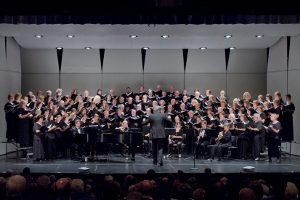“I got 15 trumpets where other women got hips, & a upright bass for both sides of my heart, I walk round in a piano like somebody else be walkin on the Earth, I live in music.” Instead of an overture, Pan Harmonia’s concert started with the lyrical poetry from Ntozake Shange‘s book, i live in music. Recited by flautist and founder of Pan Harmonia, Kate Steinbeck, the evocative imagery roused the senses, the imagination, and invited the audience to recalibrate our relationship with music before the concert even began. Following the magical first impression was Théodore Dubois’ Terzettino for flute, viola, and harp. The warm, sylvan sound of Steinbeck’s wooden flute and the heart-warming harmonic progression in the harp brought to life a certain gaiety, fulfillment, and optimism.
Based out of Asheville, NC, Pan Harmonia pulls from both classic and contemporary repertoire. As an artistic and social force, Pan Harmonia has been bringing music to communities throughout the state for over 20 years. Notably, the group is also dedicated to programming works by lesser-known composers, especially women and people of color. Featured in the sold-out performance for Chamber Music Raleigh‘s inaugural concert of the Sights and Sounds Series was Steinbeck on flute, John Wickey on harp, and Arthur Ross III on viola.
Although I thoroughly enjoyed the personality each member shared with the audience, I don’t think this performance was Pan Harmonia’s best showing. Yes, the program was progressive as far as typical chamber ensembles go, but unfortunately, unreliable intonation, tactless releases, and inconsistent interpretation and execution of melodic lines were common throughout the performance. While I appreciated the sonic variety of the program of alternating solo and ensemble works, the solo performances exposed who was mentally and practically prepared to connect with the audience and who wasn’t. Even in the final number of the concert, a Sondheim medley which was nicely arranged by Wickey, members of the group were missing notes and rhythms in songs that audience members surely recognized. Additionally, I’ve been to concerts before where ensembles have had to stop and restart a piece (it happens to even the best of us), but to ask an audience to sit with the discomfort of a restart after waiting to be seated for half an hour after the scheduled concert start time felt unprofessional and taxing.
More seriously than minor inconveniences and mistakes, I think it’s worth exploring Steinbeck’s performance of the solo flute piece, Kokopeli, by composer and flutist Katherine Hoover. Based on the Hopi and Southwestern indigenous legendary figure Kokopeli and influenced by Native American flute songs and sounds, the work aims to capture the spaciousness of the Southwest and the Hopi’s kinship with their land. As a pioneer of contemporary flute composition, Hoover’s success is a legacy for women in music, but without the appropriate connections to traditional indigenous knowledge, I find issue in the influence that compelled Hoover to write the piece. Themes of indigenous music especially have been victim to misrepresentations by major composers in Hollywood and concert music circles. By extension, it felt like the choice to program Kokopeli, regardless of its popularity among flutists and the artistic commitment of Steinbeck, gave an impression of exoticism and likely reinforced a colonial hierarchy of extracting indigenous aesthetics. Admittedly, this is a bold claim to make for a non-indigenous, white, male writer, but for a group that is dedicated to programming music from underrepresented and marginalized artists, I expected more attention to the appropriate sourcing of cultural music.
Programming new and diverse music is certainly buzzing in concert music circles in the U.S., but such programming requires a bit more consideration and attention to detail. Aesthetically speaking, Pan Harmonia chose an artistically varied program of works. For me, the execution and details of the performance didn’t serve the music or the audience in the way I hope the ensemble intended. I don’t believe that my singular experience with Pan Harmonia is representation of their 20-year legacy, but I would like to encourage the ensemble to continue growing in their programmatic and artistic ventures.











